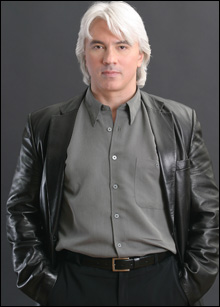
FILLING JORDAN HALL: Belshazzar didn’t, Hvorostovsky did.
|
The classical-music season is winding up without winding down. So many notable events have been taking place, you’d think we had months to go before summer-festival time. Pianist Russell Sherman’s complete Mozart sonata series at Emmanuel Church, for example, was intended, he said, “not to define Mozart, but to see the splendors of his universe.” Splendors abounded at the last concert — maybe my favorite of the ones I attended. Sherman began and ended with sonatas in C major — the brilliant and sophisticated K.330 (Mozart at 22) and the famous “musical snuff box,” K.545 (Mozart at 32 — already a late work), of which Emmanuel Music director Craig Smith wrote, “You have to be very young, or old and wise to bring it off.” Sherman’s forward-leaning asymmetrical phrasing, even in this most symmetrical of sonatas; the way Mozart’s decorative effects always spin out of, and return to, the musical line; the exposure of shadowy inner harmonies — all these were present in the most exploratory and compelling version of this “simple” sonata I’ve ever heard. Sherman was joined by some of Emmanuel’s most remarkable alums — Peggy Pearson (oboe), Bruce Creditor (clarinet), Neil DeLand (horn), and Thomas Stephenson (bassoon) — for Mozart’s E-flat Quintet for Piano and Winds (K. 482), a work that, in its overlapping of individual voices and timbres, reminds me of the heartbreaking operatic ensembles of Le nozze diFigaro and Cosí fan tutte, the exquisite elegance of Mozart’s serenades, and the deep poignance of his most serious chamber music.
The evening — and the series — ended with Sherman’s only encore (he called it an “anti-encore”): Ferruccio Busoni’s transcription of the stormy, melancholy Andantino of Mozart’s first great piano concerto, No. 9 in E-flat, K.271, which the great master dedicated to his student Eduard Steuermann, Russell Sherman’s great teacher.
Several of the players in the quintet were also in the Cantata Singers orchestra for an ambitious season closer, Handel’s Belshazzar — a Cinemascopic oratorio dealing with the fall of Baghdad, capital of an ancient empire devoured by its own corruption, and a foolish ruler who confuses religion with morality. David Hoose and the Cantata Singers did it 17 years ago, but this time the political implications were even more immediate and inescapable. Hoose led it, the orchestra played it, and the astonishing chorus sang it, vividly distinguishing among frivolous Babylonians (“‘tis religion to be drunk”), heroic Persians, and lamenting captive Hebrews, with seething conviction.
Tenor William Hite, in firm, ringing voice, was the spoiled, self-absorbed rich-boy ruler Belshazzar. Countertenor Jeffrey Gall, his wise and cagy adversary, the Persian king Cyrus, sounded every bit as heroic and brilliant as he did when he sang the same role with Hoose in 1989, or seven years earlier than that with Donald Teeters and the Boston Cecilia. Soprano Karyl Ryczek, a Cantata Singers stalwart who sounded better than ever as Mary Magdalene in John Harbison’s But Mary Stood, continued impressively as Nitocris, Belshazzar’s despairing mother, who opens the oratorio with librettist Charles Jennens’s prescient monologue about the inevitable cycles of empire (“Arriv’d to full maturity, it grasps/At all within its reach, o’erleaps all bounds,/Robs, ravages, and wasts the frighted world./At length grown old and swell’d to bulk enormous”). Ryczek could afford to add a few more consonants to her repertoire. Baritone David Kravitz at first overplayed the role of Cyrus’s collaborator Gobryas, but eventually he settled his increasingly large voice into his customary refinement and eloquence.